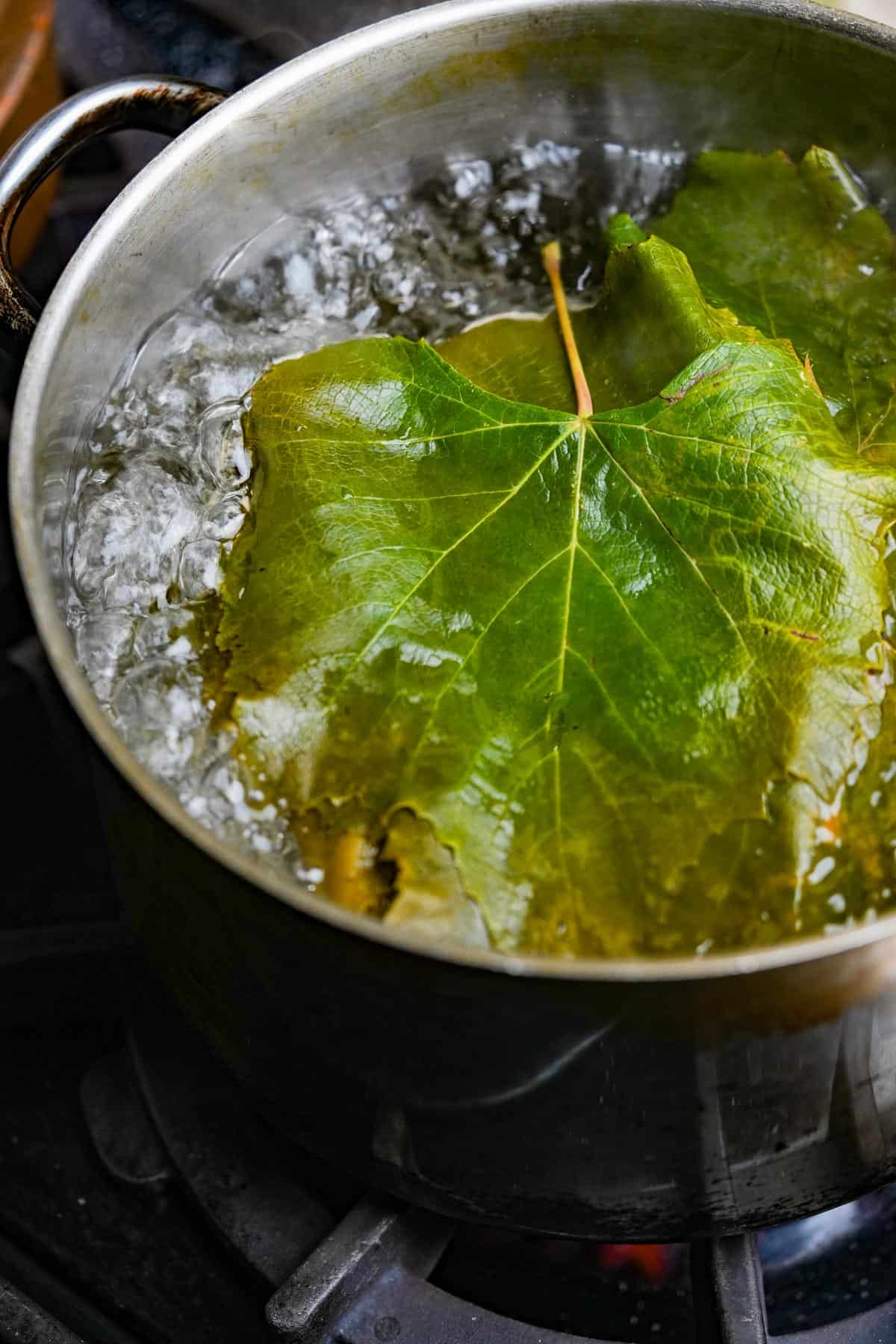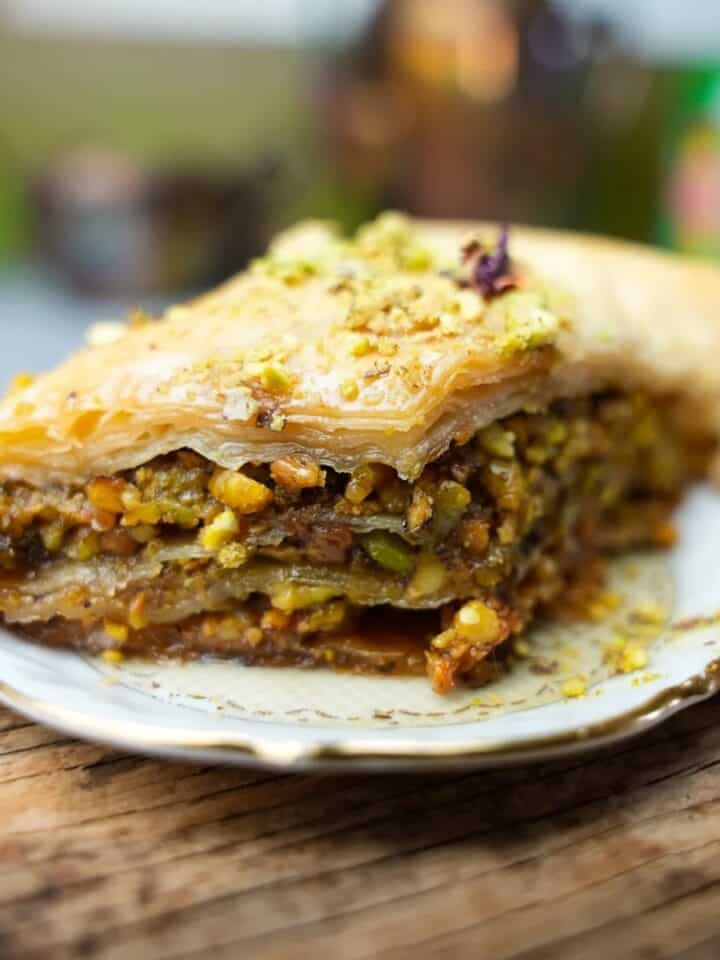*This post may contain affiliate links. Read more »
Often confused with Greek Dolmas, Yaprak Sarma is a Turkish variation of stuffed grape leaves. Unlike dolmades, these are stuffed with currants, pine nuts, and perfectly seasoned rice, and can really shine as a main course rather than a cute little appetizer. You don't need to book a flight to Istanbul to experience the magic of Yaprak Sarma. With this recipe, you'll be able to recreate this authentic Turkish treasure in your own kitchen!


Enter your email & I'll send it to your inbox. Plus, get great new recipes from me every week!
By submitting this form, you consent to receive emails from Cinnamon Snail.
Our step-by-step guide provides you with all the knowledge and skills you need to craft these stuffed vine leaves like a skilled, wrinkled grandma. They pair perfectly with other Turkish standards like bulgur pilavi, ezogelin and ezme salad.
🦘True story: I live with a rescued wallaby named Doyle, and he LOVES eating grape leaves from our vines more than just about anything!
It's time to roll up your sleeves and gather your ingredients. Like the grape leaves, your kitchen is about to be stuffed to the brim with heavenly aromas. Let's get cooking!
Jump to:
🥰Why you are going to adore the ever-loving heck outta this recipe
✊ Vegan AF: These stuffed grape leaves are 100% plant-based. Like all of my recipes, it contains no cholesterol and avoids causing harm to animals and the environment. They also happen to be gluten-free!
🍇 Grape Leaves Perfection: My recipe provides guidance on how to make these both using fresh off-the-vine grape leaves, as well as jarred prepared grape leaves. Either way, you will have no problem making these an absolute masterpiece.
🍽️ Foolproof Stuffing Technique: My stuffing method and tips guarantee that your Yaprak Sarma will hold their shape and taste fantastic every time.
✅ Tested and Approved Worldwide: Like all of my Turkish recipes, I have made these Turkish grape leaves over and over again until they were perfect, and then the recipe has been tested in kitchens all around the globe by a large group of recipe testers I work with. My testers loved it, finding success with varying ingredient brands available worldwide.


Transform Your cooking with Turkish Vegan Magic
This 6-day program is 100% FREE. Get Ready to Master Turkish Vegan Cuisine!
🍇Notable ingredients and substitutions

Grape Leaves
These tender leaves, known as "yaprak" in Turkish, are the essence of Yaprak Sarma. If fresh grape leaves are scarce, jarred ones make a suitable substitute, and help cut out a couple of steps.
Currants
Currants, called kuru üzüm in Turkey, introduce just the right subtle sweetness to the dish. Consider raisins, barberries, or chopped dried apricots for a similar effect. I have made (and loved) these with hunza raisins from northern India, which are also friggin' amazing in vegan oatmeal cookies!
Mint
Turkish nane (mint) imparts a refreshing herbal touch, balancing the flavors in Yaprak Sarma. I use it in a lot of my Turkish recipes like Yalya Corbasi drizzled with mint oil, or fellah koftesi. You can use either minced fresh mint, or crushed dried mint leaves.
Pine Nuts
Çam fıstığı" or pine nuts are the source of a delightful nutty crunch and flavor. They are also the star of my blue corn pancakes with pine nut butter. Walnuts or almonds can serve as viable substitutes.
Tatli Biber Salçası
This thick pepper paste, known as "tatli biber salçası," brings an umami depth, a little sweetness, and a vibrant hue to the dish. It's a quintessential ingredient in Turkish cuisine. If you want to make a spicier grape leaf, you can use aci biber salçası instead, made from hotter peppers. If you can’t get any, a mix of tomato paste and a pinch of red pepper flakes can emulate its flavor.
Rice
Rice, called Pirinç in Turkey forms the sturdy foundation of the stuffing. You can use brown rice if you wish, but traditionally, this is made with long-grain white rice. You can swap the rice with millet or quinoa.
*See the recipe card at the bottom of the page for exact quantities, nutritional info, and detailed cooking directions.
🤯Variations
A nice Mediterranean variation on this recipe is to replace currants with chopped sun-dried tomatoes and swap pine nuts for toasted almonds.
Or enhance the herbal notes by incorporating a mixture of fresh herbs like dill, wayyyy more parsley, and chives into the stuffing. This variation adds a vibrant green freshness to the stuffing.
📖 How to make perfect Yaprak Sarma
Nail these on your first shot by following these step-by-step instructions with important tips. Or you can follow along with the easy-to-print recipe card towards the bottom of this page.

Step One
Prepare Grape Leaves:
For fresh grape leaves, blanch in boiling water for 45 seconds, then rinse and pat dry. For jarred leaves, drain, rinse, and pat dry.

Step Two
Sauté Pine Nuts:
In a thick-bottomed pot over medium heat, toast the pine nuts for 3-4 minutes until lightly golden, then set them aside.

Step Three
Sauté Onions:
In the same pot, heat olive oil for 60 seconds. When the oil is hot, sauté onions, then stir in uncooked rice until it turns slightly translucent.

Step Four
Simmer with Flavors:
Add water, lemon juice, and tatli biber salçası (or tomato paste) into the pot. Stir in diced tomatoes, currants, dried mint, black pepper, cinnamon, sugar, and salt. Place a lid on the pot and bring up to a vigorous steam over high heat. Then reduce the heat to low and simmer for 15-18 minutes, covered until the rice is just tender.

Step Five
Upgrade with Herbs:
Off the heat, stir in the toasted pine nuts, fresh dill, and flat-leaf parsley to infuse the stuffing with herbal goodness.

Step Six
Roll Grape Leaves:
Place a grape leaf on a clean surface, add a spoonful of stuffing, and tightly roll it, tucking in the sides like a thin, long burrito. Repeat for all grape leaves.

Step Seven
Prepare for Cooking:
Line the bottom of a pot with a few additional grape leaves to prevent sticking or burning, arrange the rolls, drizzle with olive oil, and add water to cover. Bring to a vigorous steam over medium heat, then cover and simmer over low heat for 30-35 minutes.

Step Eight
Accoutrement the whole place up:
Serve your Yaprak Sarma with mutabal, kisir, or labneh, garnish with parsley leaves, additional toasted pine nuts, and lemon wedges.
💡Serving Ideas
Pair Yaprak Sarma with a side of Turkish borlotti beans, Moroccan stewed white beans, or Zeytinyağlı Taze Fasulye Tarifi for a protein-rich accompaniment.
Include traditional sides like tabouli, cig kofte, mercimek kofte, and harira. Olive oil-braised celery root offers a lovely autumnal earthy element to the feast.
If you're craving some plant-based protein, consider serving your Yaprak Sarma alongside baharat roasted oyster mushroom shawarma or vegan kofta (made from homemade vegan chicken) on freshly grilled pita bread with tahini and shatta sauce.
To end the meal on a sweet note, delight your guests with irmik helvasi or pistachio baklava. Both are classic Turkish sweets.
👉Top tips
- Handle Grape Leaves with Care: Whether using fresh or jarred grape leaves, be gentle when working with them. If using fresh leaves, blanch them just enough to make them pliable without overcooking. For jarred leaves, rinse them thoroughly to remove excess brine. Pat them dry to prevent excess moisture in your dish. Don’t be scared, if a couple tear, as you can use them to line the bottom of the pot to prevent burning or sticking.
- Tight and Neat Rolling: When rolling the grape leaves, make sure they are tightly and neatly rolled. This takes a little practice, but if you have ever made lahana sarma (stuffed cabbage) before, these will come more easily. Just take your time to roll them carefully, and try to make each one nicer and neater than the last. Err on the side of using less filling than more if your rolling skills are kinda sucky.
- Layer Properly for Cooking: When arranging the rolled grape leaves in the cooking pot, layer them closely to prevent unraveling during cooking. Use grape leaves at the bottom to avoid sticking, and ensure they're well-oiled for a delicious result.
- Simmer Slow and Steady: When cooking the Yaprak Sarma, opt for a slow and steady simmer in a covered pot. A Dutch oven is ideal, because it is thick and will radiate the heat most evenly.
🤷♀️FAQ
Dolmades and Yaprak Sarma share similarities as both are stuffed grape leaves, but they have some differences. Dolmades are a Greek dish that typically includes rice, herbs, and occasionally ground meat (such as ground beef), wrapped in grape leaves and often served cold as an appetizer. Yaprak Sarma, on the other hand, are Turkish grape leaves stuffed with rice, herbs, pine nuts, and currants, and are usually served warm as a main course.
The seasoning and preparation methods may also vary between the two, resulting in distinct flavor profiles.
Grape leaves are the edible leaves of grapevines. You can find them online, or in the international or canned goods section of many grocery stores.
Make sure to rinse jarred grape leaves thoroughly to remove excess brine, and for fresh leaves, blanch them and rinse them under cold water to separate them. When cooking, just make sure you drizzle oil evenly onto the grape leaves. They tend not to stick when cooking anyway, so don't stress!
Yes, you can prepare Yaprak Sarma in advance and refrigerate them for up to four days. They often taste better the next day.
Yes, you can freeze Yaprak Sarma before or after cooking. Just ensure they are well-sealed to prevent freezer burn, and allow them to thaw in the fridge before reheating in a steamer.
✌️My faves to serve with this dish:
Say Hi on Social! 👋
Follow me on Instagram & Facebook for more recipes.
❤️Love this recipe? It helps me out greatly if you leave a 5-star 🌟🌟🌟🌟🌟rating in the recipe card below and maybe even leave me a lovey-dovey comment too!

Yaprak Sarma (Vegetarian Turkish Stuffed Grape Leaves)
Equipment
Ingredients
For the leaves:
- 1.1 lbs. fresh grape leaves or use 454 g. of jarred prepared grape leaves
- ⅓ cup extra virgin olive oil
Stuffing:
- ⅓ cup pine nuts
- 4 teaspoons olive oil
- ½ cup onion diced
- 1 cup rice uncooked
- 1 ⅔ cups water
- 3 tablespoons lemon juice
- 1 cup tomato diced
- 1 tablespoon tatli biber salçası Turkish pepper paste, or tomato paste
- 1 tablespoon dried mint
- ¼ cup dried currants
- ½ teaspoon ground black pepper
- ¾ teaspoon cinnamon
- 1 teaspoon sugar
- 1 teaspoon salt or to taste
- ¼ cup fresh dill chopped
- ½ cup flat-leaf parsley chopped
- ¼ cup extra virgin olive oil
- ⅓ cup water
To serve:
- ⅓ cup mutabal or labneh (optional)
- 1 tablespoon pine nuts toasted
- Flat-leaf parsley leaves
- Fresh lemon wedges
Instructions
- If using fresh grape leaves, blanch them for 45 seconds in boiling water and then rinse and pat dry. For jarred grape leaves, drain, rinse, and pat them dry.
- In a Dutch oven or thick-bottomed pot over medium heat, toast the pine nuts for 3-4 minutes until lightly golden, then set them aside.
- In the same pot, heat olive oil for 60 seconds over medium heat. When the oil is hot, sauté onions for three minutes until slightly translucent.
- Add the rice, water, lemon juice, and tatli biber salçası (or tomato paste) into the pot. Stir in diced tomatoes, currants, dried mint, black pepper, cinnamon, sugar, and salt. Place a lid on the pot and bring up to a vigorous steam over high heat. Then reduce the heat to low and simmer for 15-18 minutes covered until the rice is just tender.
- Remove from heat and stir in the toasted pine nuts, fresh dill, and finely chopped flat-leaf parsley into the rice filling.
- Place a grape leaf on a clean surface, add a tablespoon of the stuffing, and roll it tightly, tucking in the sides like a thin burrito. If there are any tears in the grape leaf, you can double wrap using a second grape leaf. Repeat with all grape leaves and stuffing.
- Line the bottom of a pot with a few additional grape leaves to prevent sticking, arrange the rolls over the bottom (it’s ok to stack them), drizzle all over with olive oil, and add water. Bring to a vigorous steam over medium heat, then cover and simmer over low heat for 30-35 minutes.
- Serve either hot or at room temperature and garnish with parsley leaves, additional pine nuts, and lemon wedges.
Notes

Enter your email & I'll send it to your inbox. Plus, get great new recipes from me every week!
By submitting this form, you consent to receive emails from Cinnamon Snail.












Kitty says
I reduced the cinnamon to one-quarter teaspoon, left out the tomato/pepper paste and used fresh mint because I had no dried mint. I also used molasses instead of sugar, cooked the rice in chicken stock instead of water, lightly chopped the toasted pine nuts to distribute them more evenly. Turned out DELICIOUS! I’m serving these tonight for New Year’s Eve. Thank you for sharing your recipe!
Adam Sobel says
So glad they came out awesome! Yeah, my recipe is a bit cinnamon-y, but that's how I like these. Have a wonderful 2024 ❤️